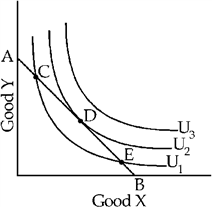Figure 5-13

In Figure 5-13, the slope of the budget line (dropping all minus signs) equals
a.
price of good X/price of good Y.
b.
price of good Y/price of good X.
c.
the minimum number of units of good Y the consumer would have to receive to make him willing to give up one unit of good X.
d.
the minimum number of units of good X the consumer would have to receive to make him willing to give up one unit of good Y.
a
You might also like to view...
Property rights that protect inventions are called
A) trademarks. B) copyrights. C) patents. D) exclusive franchises.
A market is classified as monopolistically competitive when
A) there is a barrier that blocks entry by other firms. B) a small number of firms compete. C) many firms produce the same product. D) many firms produce a slightly differentiated product. E) there is one firm that sells a good or service with no close substitutes.
The process of supply and demand
A) guarantees shortages or surpluses will never exist. B) guarantees the greatest amount of social happiness. C) ensures that people will be able to obtain all that they need. D) generates useful information regarding the relative scarcities of goods and services. E) accomplishes all of the above.
An Australian investor buys a U.S. Treasury bond that has a price of $10,000 . pays 5 percent interest, and matures in a year. Between the purchase date and the maturity date, the exchange rate changes from $1 = AUD 5.0 to $1= AUD 5.2 . What will be the Australian investor's rate of return from the U.S. bond?
a. 4 percent b. 7 percent c. 9.2 percent d. 12 percent e. 25 percent